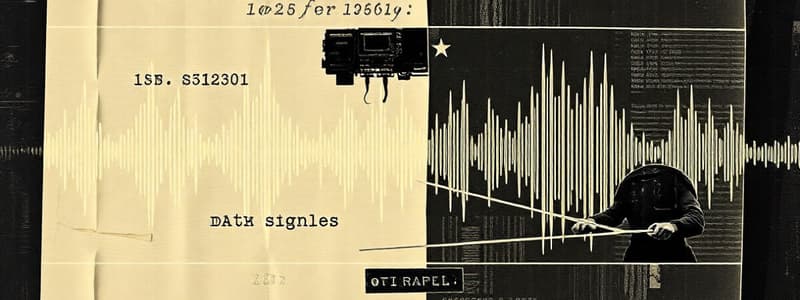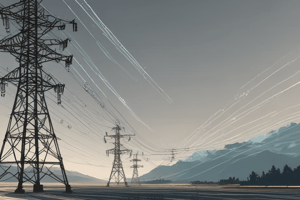Podcast
Questions and Answers
What is the main difference between baseband and broadband transmission methods?
What is the main difference between baseband and broadband transmission methods?
Baseband transmission uses the entire bandwidth of the media for a single channel, while broadband allows multiple channels within the same bandwidth.
How does the number of levels in a digital signal affect the number of bits required per level?
How does the number of levels in a digital signal affect the number of bits required per level?
The number of bits required per level is calculated as $log_2 L$, where L is the number of levels.
What role does scrambling play in digital communication?
What role does scrambling play in digital communication?
Scrambling is used to randomize the signal for better transmission quality and to help avoid long sequences of zeros or ones.
Define guided transmission media and provide an example.
Define guided transmission media and provide an example.
What distinguishes un-guided transmission media from guided transmission media?
What distinguishes un-guided transmission media from guided transmission media?
What are line coding techniques, and why are they important in digital communication?
What are line coding techniques, and why are they important in digital communication?
Explain block coding in the context of data transmission.
Explain block coding in the context of data transmission.
What is the significance of bandwidth in data transmission?
What is the significance of bandwidth in data transmission?
What are the two main types of twisted pair cables used in data communications?
What are the two main types of twisted pair cables used in data communications?
Which transmission medium offers the highest bandwidth according to the comparison provided?
Which transmission medium offers the highest bandwidth according to the comparison provided?
What is the advantage of using stranded twisted pair cables over solid twisted pair cables?
What is the advantage of using stranded twisted pair cables over solid twisted pair cables?
Identify the cable type that is not used in data communications as mentioned in the content.
Identify the cable type that is not used in data communications as mentioned in the content.
What are the two types of coaxial cables mentioned, and what is their typical use?
What are the two types of coaxial cables mentioned, and what is their typical use?
Why is fiber-optic cable becoming increasingly popular for LAN applications?
Why is fiber-optic cable becoming increasingly popular for LAN applications?
What is the bandwidth range for twisted pair cables as stated in the comparison table?
What is the bandwidth range for twisted pair cables as stated in the comparison table?
Explain the difference in conductor structure between solid and stranded twisted pair cables.
Explain the difference in conductor structure between solid and stranded twisted pair cables.
What is the primary purpose of line coding in digital transmission?
What is the primary purpose of line coding in digital transmission?
How does block coding enhance data transmission?
How does block coding enhance data transmission?
Name two types of guided transmission media and their typical use cases.
Name two types of guided transmission media and their typical use cases.
What is scrambling in digital communication, and why is it used?
What is scrambling in digital communication, and why is it used?
Describe the role of un-guided transmission media in modern communications.
Describe the role of un-guided transmission media in modern communications.
Explain the importance of analog-to-digital conversion in data transmission.
Explain the importance of analog-to-digital conversion in data transmission.
What distinguishes guided transmission media from un-guided transmission media?
What distinguishes guided transmission media from un-guided transmission media?
Identify one application of microwave transmission in data communication.
Identify one application of microwave transmission in data communication.
What happens to the bit rate when required bandwidth increases in baseband transmission?
What happens to the bit rate when required bandwidth increases in baseband transmission?
Explain the significance of frequency-division multiplexing in broadband communication.
Explain the significance of frequency-division multiplexing in broadband communication.
What does attenuation refer to in the context of signal transmission?
What does attenuation refer to in the context of signal transmission?
How does distortion affect composite signals during transmission?
How does distortion affect composite signals during transmission?
What role does noise play in signal impairment?
What role does noise play in signal impairment?
Why is a negative decibel value significant in signal transmission?
Why is a negative decibel value significant in signal transmission?
What are the implications of having two pathways in broadband communication?
What are the implications of having two pathways in broadband communication?
Identify a method to counteract the effects of attenuation.
Identify a method to counteract the effects of attenuation.
How does the representation of digital data differ from analog data?
How does the representation of digital data differ from analog data?
What is the significance of bandwidth in composite periodic analog signals?
What is the significance of bandwidth in composite periodic analog signals?
In baseband transmission, how is data sent through the transmission media?
In baseband transmission, how is data sent through the transmission media?
What does a high signal-to-noise ratio (SNR) indicate about a signal?
What does a high signal-to-noise ratio (SNR) indicate about a signal?
What mathematical relationship defines the number of bits required per level in a digital signal?
What mathematical relationship defines the number of bits required per level in a digital signal?
In the context of data transmission, how does increasing bandwidth affect data rate?
In the context of data transmission, how does increasing bandwidth affect data rate?
Why can’t frequency-division multiplexing be used in baseband transmission?
Why can’t frequency-division multiplexing be used in baseband transmission?
Why is the Nyquist bit rate used for noiseless channels, and what is its formula?
Why is the Nyquist bit rate used for noiseless channels, and what is its formula?
What characterizes a composite periodic analog signal?
What characterizes a composite periodic analog signal?
Describe the relationship between Shannon capacity and signal-to-noise ratio (SNR).
Describe the relationship between Shannon capacity and signal-to-noise ratio (SNR).
What is the role of levels in digital signals regarding data transmission capacity?
What is the role of levels in digital signals regarding data transmission capacity?
Describe the nature of digital signals in terms of their frequency range.
Describe the nature of digital signals in terms of their frequency range.
What limits the number of signal levels L in increasing the bit rate according to the Nyquist formula?
What limits the number of signal levels L in increasing the bit rate according to the Nyquist formula?
In what two contexts is the term bandwidth used in networking?
In what two contexts is the term bandwidth used in networking?
Explain why the bandwidth of a channel can impact signal transmission quality.
Explain why the bandwidth of a channel can impact signal transmission quality.
What is the significance of measuring SNR in decibels (SNRdB)?
What is the significance of measuring SNR in decibels (SNRdB)?
What is the relationship between baud rate and bit rate in analog transmission?
What is the relationship between baud rate and bit rate in analog transmission?
Explain the formula $S = \frac{N}{r}$ in the context of baud rate.
Explain the formula $S = \frac{N}{r}$ in the context of baud rate.
How does throughput differ from bandwidth?
How does throughput differ from bandwidth?
What are the four types of signal encoding mentioned, and why is encoding important?
What are the four types of signal encoding mentioned, and why is encoding important?
Define what a modem does in the context of digital-to-analog conversion.
Define what a modem does in the context of digital-to-analog conversion.
What does the ratio $r$ represent in the context of baud rate calculations?
What does the ratio $r$ represent in the context of baud rate calculations?
Why is it critical to aim for higher data rates while decreasing signal rates?
Why is it critical to aim for higher data rates while decreasing signal rates?
What is the significance of the digital-to-analog conversion technique in communication?
What is the significance of the digital-to-analog conversion technique in communication?
How does the structural difference between UTP and STP cables affect their application in different environments?
How does the structural difference between UTP and STP cables affect their application in different environments?
Explain why the drop in the price of fiber-optic cables is significant for LAN applications.
Explain why the drop in the price of fiber-optic cables is significant for LAN applications.
What technical characteristics make coaxial cables less common in modern data communications?
What technical characteristics make coaxial cables less common in modern data communications?
Discuss the implications of using solid versus stranded twisted pair cables in networking environments.
Discuss the implications of using solid versus stranded twisted pair cables in networking environments.
What factors contribute to the larger bandwidth capacity of optical fiber cables compared to twisted pair cables?
What factors contribute to the larger bandwidth capacity of optical fiber cables compared to twisted pair cables?
Analyze how the bend radius of cables can impact network installations.
Analyze how the bend radius of cables can impact network installations.
Reflect on the importance of the 0-100 MHz bandwidth range for twisted pair cables in data communications.
Reflect on the importance of the 0-100 MHz bandwidth range for twisted pair cables in data communications.
Why are two types of coaxial cables, thick net and thin net, distinguished in use?
Why are two types of coaxial cables, thick net and thin net, distinguished in use?
What is the reason for modulating an analog signal if it is already analog?
What is the reason for modulating an analog signal if it is already analog?
What technique is commonly used to convert an analog signal to digital data before transmission?
What technique is commonly used to convert an analog signal to digital data before transmission?
What are the three techniques involved in digital-to-digital conversion?
What are the three techniques involved in digital-to-digital conversion?
Can you name a type of un-guided transmission medium and its typical application?
Can you name a type of un-guided transmission medium and its typical application?
What type of guided transmission medium uses light waves to transmit data?
What type of guided transmission medium uses light waves to transmit data?
In the context of data transmission, what is the main characteristic that distinguishes guided media from un-guided media?
In the context of data transmission, what is the main characteristic that distinguishes guided media from un-guided media?
Identify one of the three types of wireless media used in un-guided transmission.
Identify one of the three types of wireless media used in un-guided transmission.
What distinguishes Pulse Code Modulation from other analog-to-digital conversion techniques?
What distinguishes Pulse Code Modulation from other analog-to-digital conversion techniques?
Flashcards
Analog-to-Analog Conversion
Analog-to-Analog Conversion
Representing analog information using an analog signal.
Analog-to-Digital Conversion
Analog-to-Digital Conversion
Changing an analog signal into digital data.
Digital-to-Digital Conversion
Digital-to-Digital Conversion
Representing digital data using digital signals.
Un-Guided Transmission Media
Un-Guided Transmission Media
Signup and view all the flashcards
Guided Transmission Media
Guided Transmission Media
Signup and view all the flashcards
Radio waves
Radio waves
Signup and view all the flashcards
Microwaves
Microwaves
Signup and view all the flashcards
Optical Fiber
Optical Fiber
Signup and view all the flashcards
Analog Data
Analog Data
Signup and view all the flashcards
Digital Data
Digital Data
Signup and view all the flashcards
Baseband Transmission
Baseband Transmission
Signup and view all the flashcards
Bandwidth
Bandwidth
Signup and view all the flashcards
Data rate
Data rate
Signup and view all the flashcards
Baud rate
Baud rate
Signup and view all the flashcards
Digital signal levels
Digital signal levels
Signup and view all the flashcards
Composite Analog signal
Composite Analog signal
Signup and view all the flashcards
Twisted Pair Cable
Twisted Pair Cable
Signup and view all the flashcards
UTP
UTP
Signup and view all the flashcards
STP
STP
Signup and view all the flashcards
Bandwidth (Network)
Bandwidth (Network)
Signup and view all the flashcards
Bandwidth Comparison (Guided Media)
Bandwidth Comparison (Guided Media)
Signup and view all the flashcards
Coaxial Cable
Coaxial Cable
Signup and view all the flashcards
Optical Fiber Cable
Optical Fiber Cable
Signup and view all the flashcards
Network Cable Types
Network Cable Types
Signup and view all the flashcards
Analog Data
Analog Data
Signup and view all the flashcards
Digital Data
Digital Data
Signup and view all the flashcards
Baseband Transmission
Baseband Transmission
Signup and view all the flashcards
Bandwidth
Bandwidth
Signup and view all the flashcards
Data Rate
Data Rate
Signup and view all the flashcards
Baud Rate
Baud Rate
Signup and view all the flashcards
Digital Signal Levels
Digital Signal Levels
Signup and view all the flashcards
Composite Analog Signal
Composite Analog Signal
Signup and view all the flashcards
Baseband Transmission
Baseband Transmission
Signup and view all the flashcards
Broadband Transmission
Broadband Transmission
Signup and view all the flashcards
Transmission Impairment
Transmission Impairment
Signup and view all the flashcards
Attenuation
Attenuation
Signup and view all the flashcards
Distortion
Distortion
Signup and view all the flashcards
Noise
Noise
Signup and view all the flashcards
Bandwidth (transmission)
Bandwidth (transmission)
Signup and view all the flashcards
Decibel (dB)
Decibel (dB)
Signup and view all the flashcards
Signal-to-Noise Ratio (SNR)
Signal-to-Noise Ratio (SNR)
Signup and view all the flashcards
SNRdB
SNRdB
Signup and view all the flashcards
Data Rate
Data Rate
Signup and view all the flashcards
Nyquist Bit Rate
Nyquist Bit Rate
Signup and view all the flashcards
Shannon Capacity
Shannon Capacity
Signup and view all the flashcards
Bandwidth (in Hertz)
Bandwidth (in Hertz)
Signup and view all the flashcards
Bandwidth (in bits/sec)
Bandwidth (in bits/sec)
Signup and view all the flashcards
Noise Types
Noise Types
Signup and view all the flashcards
Baud Rate
Baud Rate
Signup and view all the flashcards
Analog-to-Analog Conversion
Analog-to-Analog Conversion
Signup and view all the flashcards
Bit Rate
Bit Rate
Signup and view all the flashcards
Analog-to-Digital Conversion
Analog-to-Digital Conversion
Signup and view all the flashcards
Data Rate
Data Rate
Signup and view all the flashcards
Un-Guided Transmission Media
Un-Guided Transmission Media
Signup and view all the flashcards
Throughput
Throughput
Signup and view all the flashcards
Guided Transmission Media
Guided Transmission Media
Signup and view all the flashcards
Radio Waves (Wireless LANs)
Radio Waves (Wireless LANs)
Signup and view all the flashcards
Bandwidth
Bandwidth
Signup and view all the flashcards
Digital-to-Analog Conversion
Digital-to-Analog Conversion
Signup and view all the flashcards
Microwaves (Communication)
Microwaves (Communication)
Signup and view all the flashcards
Categories of Transmission Media
Categories of Transmission Media
Signup and view all the flashcards
Analog Signal
Analog Signal
Signup and view all the flashcards
Digital Data
Digital Data
Signup and view all the flashcards
Relationship Between Baud and Bit Rate
Relationship Between Baud and Bit Rate
Signup and view all the flashcards
Twisted Pair Cable
Twisted Pair Cable
Signup and view all the flashcards
UTP
UTP
Signup and view all the flashcards
STP
STP
Signup and view all the flashcards
Bandwidth (Network)
Bandwidth (Network)
Signup and view all the flashcards
Bandwidth (Guided Media)
Bandwidth (Guided Media)
Signup and view all the flashcards
Coaxial Cable
Coaxial Cable
Signup and view all the flashcards
Optical Fiber Cable
Optical Fiber Cable
Signup and view all the flashcards
Cable Type Comparison
Cable Type Comparison
Signup and view all the flashcards
Study Notes
Data Transmission on Physical Media
- Data can be analog or digital. Analog data are continuous, digital data are discrete.
- Signals can be analog or digital. Analog signals have infinite values, digital signals have limited values.
- Periodic analog signals can be simple (sine wave) or composite (multiple sine waves).
- Bandwidth is the difference between the highest and lowest frequencies in a composite signal.
- Digital signals can have multiple levels, allowing the transmission of more than one bit per level.
- Number of bits per level = log₂ (number of levels).
- Baseband transmission uses the entire bandwidth for a single channel, unidirectional, no frequency division multiplexing.
- Broadband transmission uses different parts of the spectrum for different channels, bidirectional, frequency division multiplexing is possible.
- Data rate is the number of bits transmitted per second.
- Transmission impairments include attenuation (loss of energy), distortion (change in signal shape), and noise (unwanted signals).
- Decibels (dB) measure the relative strength of signals.
- Signal-to-noise ratio (SNR) is the ratio of signal power to noise power, higher is better.
- Nyquist bit rate is the theoretical maximum bit rate for a noiseless channel (2 * bandwidth * log₂(L) where L is the number of signal levels).
- Shannon capacity is the theoretical maximum bit rate for a noisy channel (bandwidth * log₂(1 + SNR)).
- Bandwidth, in networking, refers also to the range of frequencies a channel can pass, and the speed of bits transmission.
- Baud rate is the number of signal changes per second.
- Throughput is the actual data transmission rate (in bits per second) through a network, which is usually lower than the bandwidth.
- Digital-to-analog conversion changes digital data into analog signals.
- Analog-to-analog conversion changes one type of analog signal into another.
- Analog-to-digital conversion changes analog signals into digital data.
Transmission Media Categories
- Transmission media are categorized as guided (wired) and unguided (wireless).
- Guided media includes twisted-pair cable, coaxial cable, fiber-optic cable, and twisted pair.
- Unguided media includes radio waves, microwaves, and infrared waves.
- Bandwidths for different types of guided media vary.
Studying That Suits You
Use AI to generate personalized quizzes and flashcards to suit your learning preferences.





